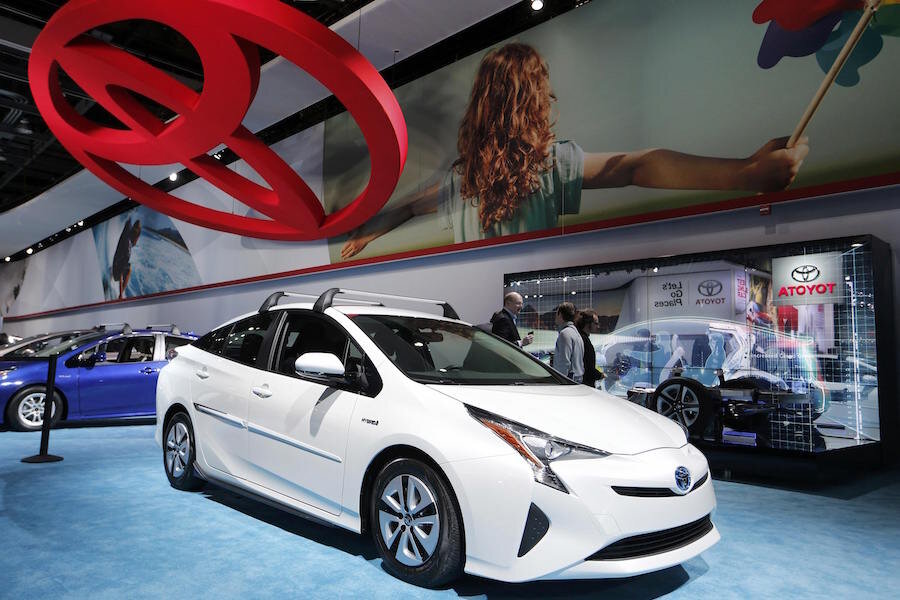2016 Toyota Prius vs. Chevy Volt: Which 'green' bestseller is right for you?
Loading...
Going green has never been easier. Some of the most fuel-efficient vehicles on the road are brand-new this year, and by our ratings, they're scoring better than ever in their lifetimes.
But when it comes down to purchasing one of the big green mainstays, which one's better for you--the new Toyota Prius, or the latest Chevrolet Volt?
Now entering its fourth generation, the legendary status of the Toyota Prius hybrid is completely established. It remains the most highly-rated car for fuel efficiency sold in the U.S. without a plug—this year at either 52 or 56 miles per gallon combined—and it’s by far the most prolific hybrid in the world, with more than 3 million sold.
The range-extended electric Chevy Volt is also all-new this year, entering its second generation. It now lets its drivers cover about 50 miles purely on electric power from the grid, used to recharge its battery, after which it too becomes a conventional hybrid—with a rated fuel efficiency of 42 mpg.
In its early years, the Volt drew long-time Prius owners out of their cars-- indicating that the hybrid-electric vehicle is no longer the pinnacle of technology chic it was when it launched. The Volt offered not only hybrid-level fuel economy (or close) but the superior driving experience of an electric car without any of the range anxiety of a battery-only vehicle.
For 2016, new generations of each vehicle face off directly. The new Volt is on sale only in California and a handful of other states, with a national launch of the 2017 model coming early in 2016. The 2016 Prius will start to arrive at dealers in January and February.
While the Prius family also includes a smaller Prius C subcompact and a larger Prius V wagon, it’s the new five-door Prius Liftback that competes most directly with the new Chevy Volt.
For the first time, the Prius Liftback offers two different battery packs. The base Prius Two sticks with the well-known and cheaper nickel-metal-hydride pack, while the Prius Three and higher models go with a smaller, lighter lithium-ion pack. For gas mileage, there’s the Prius Two Eco model, which is rated at 56 mpg combined. All other Prius models come in at 52 mpg combined.
Like all Priuses before, the car gets at most a mile of electric range, when driven gently at low speeds. Otherwise, the electric motor recaptures otherwise wasted energy and assists the highly efficient gasoline engine by adding torque so fuel consumption is reducing.
The Volt’s 42 mpg combined is lower than that, obviously, but its 18.4-kilowatt-hour battery is rated at 53 miles of electric range for 2016—and our tests indicate that’s a realistic number, at least in temperate climates. Once the pack is depleted, the Volt's gasoline engine switches on as needed and the car operates as a conventional hybrid until its pack is recharged again.
Which car is better at saving gasoline—and money? If you do 150 miles a day, the Prius wins. If you do 50 miles a day, the Volt wins. If you're somewhere in the middle, the math gets complex. Volt owner who covers less than 50 miles a day and recharges every night may not switch on his engine for weeks at a time. Owners may easily record "gas mileage" of 100 to 400 miles per gallon under those circumstances.
It taks up to 9 hours to recharge the Volt’s battery on regular 120-Volt household current, or about 4 hours with a 240-volt Level 2 charging station. The conventional hybrid Prius doesn't plug in at all.
Both cars share a basic profile: They’re high-tailed five-door liftbacks. Both have a roofline that stays high and then drops off abruptly, though the new Volt has dispensed with the two-piece rear window that the Prius retains. The Prius is bigger inside and can seat five, while the Volt’s fifth “seating position” is only for small, slending, and limber riders—and even then only for short distances—and it has less load space as well.
While the Volt has gotten more conventional looking, the latest Prius is even odder-looking than its predecessors, with a rear end whose taillights are shaped something like question marks, or perhaps squiggles. Both cars have far nicer interiors and information display graphics than their predecessors. The Chevy has slightly more conventional controls than the Prius, which still features a Space Age Multi-Information Display panel toward the base of the windshield. Both have also upgraded the materials and plastics of their interiors, with the Volt coming in as more upscale but both now tolerable.
Earlier versions of both cars scored well on safety tests, though neither of the new models has yet been rated. Both also come with standard or optional electronic safety systems that include adaptive cruise control, lane-departure warning and correction, and automatic crash braking. And the owners of both cars tend to love them, with the Volt in particular receiving the very highest owner-approval scores of any car in GM's history.
If you want the car with the highest-rated fuel economy on the market, and you're not ready to plug in your car just yet, the Prius hybrid is clearly your choice. This year’s model is quieter, smoother, far nicer inside, and—at last—drives and handles like a regular car, to the point where it’s easy to forget you’re in a Prius at all. And that was hard to say about earlier generations.
But, if you’re the kind of early adopter who bought a Prius in the early years, you may be ready for your next big leap. The new Volt retains all the good points of the previous version, while fixing almost every one of its problems. If you can’t afford a Tesla and don’t want to cope with the limitations of less than 100 miles of electric range, the Volt should be at the top of your list.







